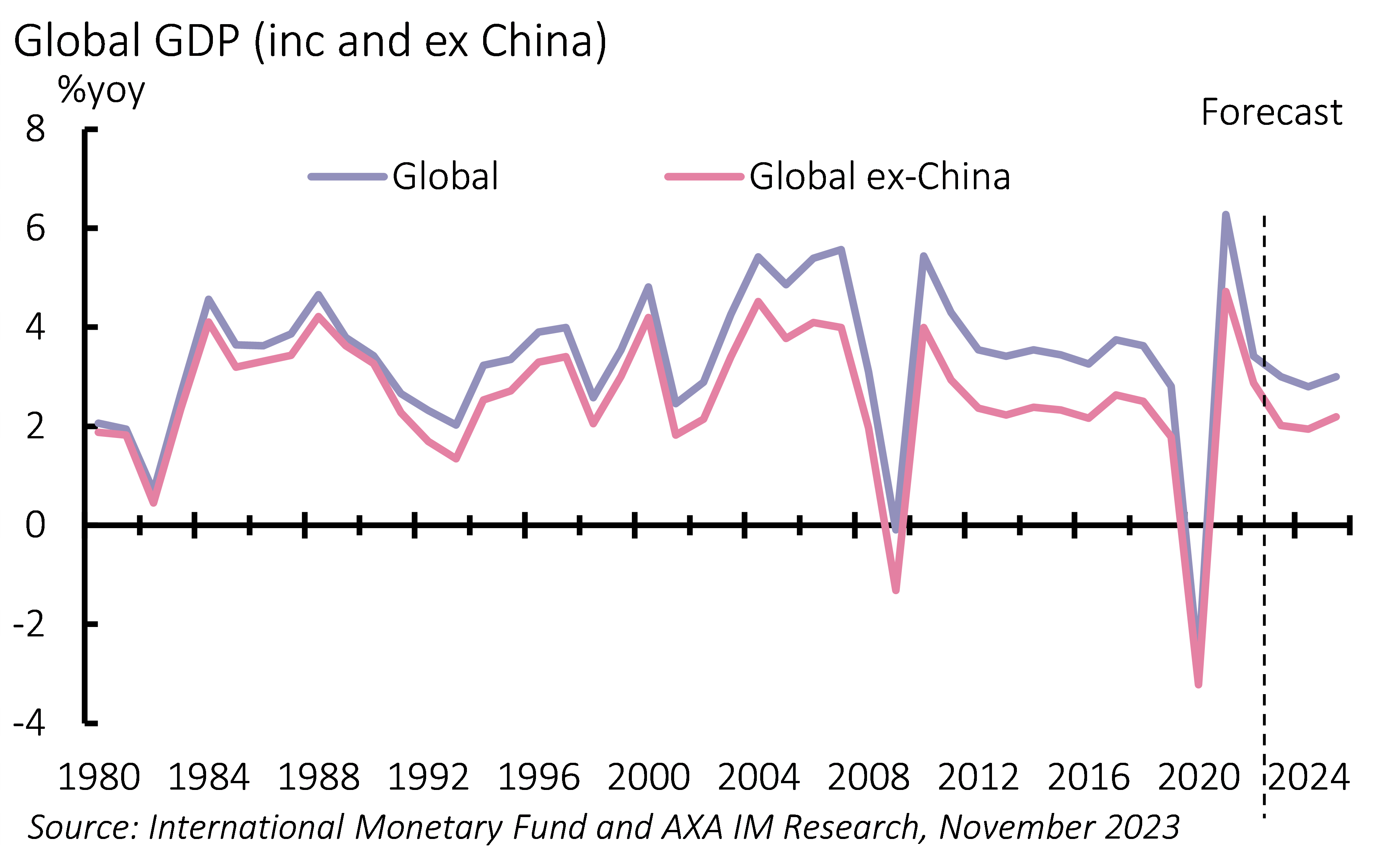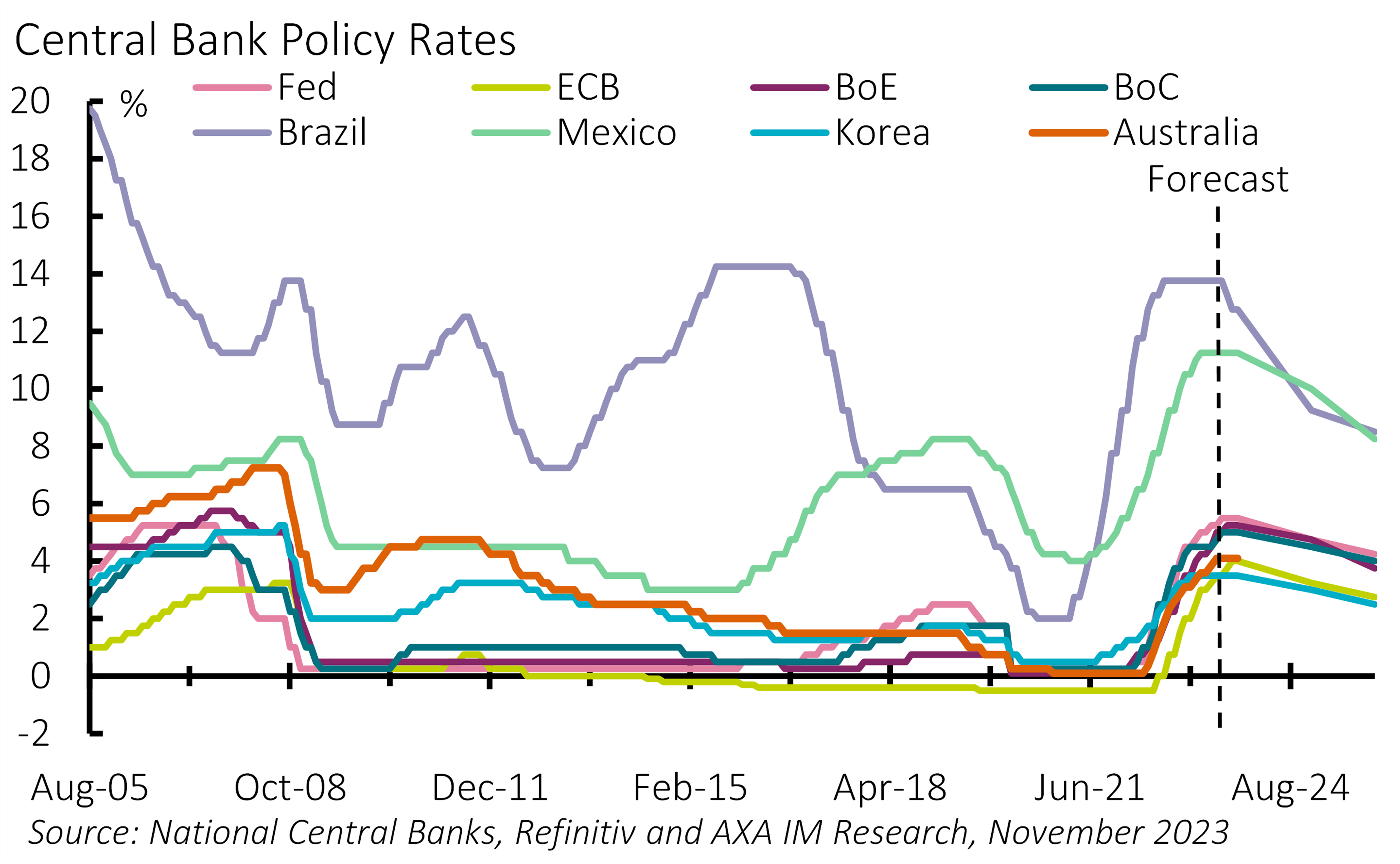
Outlook Summary – Slowing mid-cycle, not crashing end-cyc
- 04 Dicembre 2023 (5 min di lettura)
Key points
- Following 2023’s resilience, we expect global growth to slow in 2024 – this should be a mid-cycle adjustment, not an end-of-cycle collapse. 2025 should enjoy acceleration
- Central banks are likely to ease policy in the face of further disinflation but most will manage restrictive policy rather than add fresh accommodation
- 2024 will be a big year for elections. Globally the US Presidential race will likely be the most consequential
Uncertain ground
The outlook for 2024 and 2025 is built on end-of-2023 uncertainties – albeit less than there were at the start of 2020, as the world was plunged into the pandemic. Geopolitical uncertainties mirror those at the end of 2021, ahead of Russia’s invasion of Ukraine as the Middle East crisis poses a major risk to the global economy. An escalation of the conflict risks a marked impact on oil prices, regional activity and global sentiment. However, it is not obvious that escalation is the most likely path, with the US and others supporting Israel, but cautioning its actions, alongside more divergent interests across the Arabian Peninsula restraining reactionary forces.
Beyond geopolitics, there is uncertainty around the global economy’s cyclical position. This is exemplified in the US, where expectations of recession have faded. Recent economic convulsions have not been cyclical: the pandemic was an exogenous shock that forced a deep recession, resulting in supply constraint and demand-stoking policy responses. The resultant inflation was not the product of an overheating, end-of-cycle economy. Uncertainty still surrounds the degree of quasi-permanent structural change that economies have seen – as well as the balance of central bank tightening versus pent-up demand. The assessment we make is whether the economy faces an end, or mid-cycle, adjustment.
Recessions no longer central forecast
For Western economies we envisage mid-cycle adjustments. For the US, we had expected the degree of tightening from the Federal Reserve (Fed) to result in a dip in output and mild recession. But consumer resilience has delivered a slowdown by instalments. We now expect the US to enter the broadest phase of its slowdown with consumer spending forecast to ease from robust growth over the summer. This should see it slow to a below-potential pace of 1.1% in 2024, before the economy rebounds above trend by end-2025 – we forecast expansion of 1.6%. We no longer forecast outright recession. With an associated modest loosening in the labour market, inflation should reach the Fed’s mandate in 2025 but end the year modestly higher. This suggests limited room for renewed Fed accommodation. We envisage modest rate cuts (three this year, two next) but characterise these as moderating restrictiveness as opposed to outright easing.
Exhibit 1: Global growth expected to soften in 2024

European economies are facing a tougher test. Ongoing supply constraints continue to impact Eurozone economies. Solid wage growth and limited easing in labour markets should see firmer real disposable income growth as inflation falls over the next 18 months. This should mitigate risks of outright contraction, despite the weak investment backdrop. We forecast Eurozone GDP growth of 0.5% this year and just 0.3% next – weaker than consensus – before rising to 0.8% in 2025. However, even this subdued outlook is unlikely to drive inflation sharply lower as weak supply growth should limit the emergence of spare capacity. We see inflation back to target around mid-2025 and the ECB easing monetary policy, but more cautiously than markets envisage, forecasting the first cut only from June 2024, ending 2024 at 3.25% and 2025 at 2.75%.
The UK will likely face a weaker outlook. We forecast growth of 0.5% this year, 0.0% in 2024 and 0.5% in 2025 and are very wary of the lagged impact of Bank of England (BoE) monetary tightening – even though policy now appears to have peaked – with delayed mortgage resets likely to tighten monetary conditions across 2024. Our central forecast is for the UK to be on the cusp of recession; risks are skewed to contraction. Concerns of wage stickiness will likely see the BoE on hold until H2 2024, but then we think the lagged pass through of policy stimulus will require exaggerated stimulus. We forecast rates closing next year at 4.5% and 2025 at 3.75%.
Beyond cyclical dynamics
Firm action from Chinese authorities looks set to deliver China’s 2023 growth target of “around 5%” – we forecast 5.2%. Stimulus should quicken the quarterly growth pace next year, even if this equates to lower annual growth of 4.5%, before slowing in 2025 to 4.2%. We expect further stimulus if growth falters. The economy’s reliance on fiscal/infrastructure boosts is delivering an unbalanced economy and increasing resource misallocation with implications for China’s longer-term growth outlook. The longer-term remedy would be structural, market-led reforms. Yet this appears to run contrary to President Xi Jinping’s appetite for control. This creates a long-term risk for China. We do not expect this to come to fruition over the next two years, but it will hang over the longer-term outlook.
Exhibit 2: Central banks should (further) loosen policy

Japan faces longer-term change with inflation above the Bank of Japan’s (BoJ) 2% inflation target after decades of battling deflation. The BoJ has all but dismantled its yield curve control but has been cautious of further accommodation withdrawal. It is monitoring wage developments to determine its next move. Early signs suggest solid (positive real) wage growth next year. We expect the BoJ to remove its negative interest rate policy around spring and forecast a modest tightening thereafter. Yet after decades of around zero rates, the economy is vulnerable to rate adjustments. Fiscal and financial stability risks should see the BoJ raise rates only gently to 0.25% by end-2025.
Structurally stronger emerging markets
Emerging markets (EM) proved more resilient in growth terms across 2023, even as inflation fell broadly in line with expectations (though core rates remained stickier) allowing many EM central banks to ease policy. This should continue, although softer global growth and tight financial conditions are likely to prove headwinds next year. Inflation is likely to fall further, although disinflation should be driven more by core adjustments. Central banks have adopted a more cautious tone and this is likely to prevail: we expect rate cuts in 2024, but broadly consistent with stabilising real rates.
Our outlook suggests global growth slows to 2.8% in 2024, softer than the 3.0% in 2023, before accelerating to 3.0% in 2025 with most economies avoiding recession (Exhibit 1). This mid-cycle adjustment should see central bank policy rates falling – but forecast to stay at or above neutral in most regions (Exhibit 2). This has been likened to the mid-1990s US soft landing. But this is an uncomfortable comparison for EM economies, a period remembered for systemic EM crises, including Mexico (1994), Asia (1997) and Russia (1998). While conditions are set to remain tight, we note significant structural improvement since, including institutional credibility; anchored inflation expectations; floating exchange rates; better capitalised banks; and no excess capital inflows lately. Exceptions remain and tight conditions will see stresses for some but we are less concerned about the risk of a systemic shock in EM.
A protracted period of elevated rates raises average financing costs: for households, corporates and sovereigns, suggesting elevated vulnerability. Fiscally, we will monitor Italian sovereign risks – a country with elevated debt, high sovereign yields and one that has recently pushed back its plan to meet a sub-3% of GDP deficit by 2026. France has also pushed its expectation back to 2027. We also focus on the US. The latest official deficit forecasts average nearly 6% over the rest of this decade. With debt forecast at 98% for 2023, this is sustainable for now. But with debt projected to exceed 110% by 2030, markets will question future sustainability at some point.
The Trump card
Next year will be a key year for politics. More than two billion people will go to the polls, admittedly, most by virtue of India’s elections in April/May. EMs will collectively hold 19 elections in 2024 – we will pay close attention to those in Taiwan (January), South Africa (May-August) and Mexico (June). However, the most significant election for EM – and the world – is likely to be the US Presidential Election. While we are not certain it will be a re-run of the 2020’s Joe Biden-Donald Trump race, that still looks likeliest at this stage. A return of President Trump would have domestic implications in terms of adjustment to fiscal policy. However, globally its potential impact on geopolitical events poses the most uncertainty – a return to trade wars as well as questions over support for Ukraine and Israel. European elections (May) and UK elections (likely October) should also have important local impacts.
La nostra view per il 2024
Vedi tutti i contenuti

Outlook 2024: USA avanti, Europa col freno, no recessione
- A cura di
- 05 Dicembre 2023 (5 min di lettura)

Crescita globale rallenta, ma guadagni potenzialmente elevati per le obbligazioni
- A cura di ,
- 05 Dicembre 2023 (7 min di lettura)

I tassi a lungo termine e l’evoluzione del debito negli Stati Uniti e in Europa
- A cura di
- 05 Dicembre 2023 (7 min di lettura)

Outlook 2024-2025 (Webinar)
- A cura di
- 05 Dicembre 2023 (15 min di lettura)

Investment Strategy Outlook – Modest growth, modest returns
- A cura di
- 04 Dicembre 2023 (7 min di lettura)

Pensions investment outlook 2024: Mining for opportunities amid easing growth
- A cura di
- 04 Dicembre 2023 (7 min di lettura)
Disclaimer
Prima dell’investimento in qualsiasi fondo gestito o promosso da AXA Investment Managers o dalle società ad essa affiliate, si prega di consultare il Prospetto e il Documento contenente le informazioni chiave per gli investitori (KID). Tali documenti, che descrivono anche i diritti degli investitori, possono essere consultati - per i fondi commercializzati in Italia - in qualsiasi momento, gratuitamente, sul sito internet www.axa-im.it e possono essere ottenuti gratuitamente, su richiesta, presso la sede di AXA Investment Managers. Il Prospetto è disponibile in lingua italiana e in lingua inglese. Il KID è disponibile nella lingua ufficiale locale del paese di distribuzione. Maggiori informazioni sulla politica dei reclami di AXA IM sono al seguente link: https://www.axa-im.it/avvertenze-legali/gestione-reclami. La sintesi dei diritti dell'investitore in inglese è disponibile sul sito web di AXA IM https://www.axa-im.com/important-information/summary-investor-rights.
I contenuti pubblicati nel presente sito internet hanno finalità informativa e non vanno intesi come ricerca in materia di investimenti o analisi su strumenti finanziari ai sensi della Direttiva MiFID II (2014/65/UE), raccomandazione, offerta o sollecitazione all’acquisto, alla sottoscrizione o alla vendita di strumenti finanziari o alla partecipazione a strategie commerciali da parte di AXA Investment Managers o di società ad essa affiliate, né la raccomandazione di una specifica strategia d'investimento o una raccomandazione personalizzata all'acquisto o alla vendita di titoli. L’investimento in qualsiasi fondo gestito o promosso da AXA Investment Managers o dalle società ad essa affiliate è accettato soltanto se proveniente da investitori che siano in possesso dei requisiti richiesti ai sensi del prospetto informativo in vigore e della relativa documentazione di offerta.
Il presente sito contiene informazioni parziali e le stime, le previsioni e i pareri qui espressi possono essere interpretati soggettivamente. Le informazioni fornite all’interno del presente sito non tengono conto degli obiettivi d’investimento individuali, della situazione finanziaria o di particolari bisogni del singolo utente. Qualsiasi opinione espressa nel presente sito internet non è una dichiarazione di fatto e non costituisce una consulenza di investimento. Le previsioni, le proiezioni o gli obiettivi sono solo indicativi e non sono garantiti in alcun modo. I rendimenti passati non sono indicativi di quelli futuri. Il valore degli investimenti e il reddito da essi derivante possono variare, sia in aumento che in diminuzione, e gli investitori potrebbero non recuperare l’importo originariamente investito.
Ancorché AXA Investment Managers impieghi ogni ragionevole sforzo per far sì che le informazioni contenute nel presente sito internet siano aggiornate ed accurate alla data di pubblicazione, non viene rilasciata alcuna garanzia in ordine all’accuratezza, affidabilità o completezza delle informazioni ivi fornite. AXA Investment Managers declina espressamente ogni responsabilità in ordine ad eventuali perdite derivanti, direttamente od indirettamente, dall’utilizzo, in qualsiasi forma e per qualsiasi finalità, delle informazioni e dei dati presenti sul sito.
AXA Investment Managers non è responsabile dell’accuratezza dei contenuti di altri siti internet eventualmente collegati a questo sito. L’esistenza di un collegamento ad un altro sito non implica approvazione da parte di AXA Investment Managers delle informazioni ivi fornite. Il contenuto del presente sito, ivi inclusi i dati, le informazioni, i grafici, i documenti, le immagini, i loghi e il nome del dominio, è di proprietà esclusiva di AXA Investment Managers e, salvo diversa specificazione, è coperto da copyright e protetto da ogni altra regolamentazione inerente alla proprietà intellettuale. In nessun caso è consentita la copia, riproduzione o diffusione delle informazioni contenute nel presente sito.
AXA Investment Managers può decidere di porre fine alle disposizioni adottate per la commercializzazione dei suoi organismi di investimento collettivo in conformità a quanto previsto dall'articolo 93 bis della direttiva 2009/65/CE.
AXA Investment Managers si riserva il diritto di aggiornare o rivedere il contenuto del presente sito internet senza preavviso.
A cura di AXA IM Paris – Sede Secondaria Italiana, Corso di Porta Romana, 68 - 20122 - Milano, sito internet www.axa-im.it.
© 2024 AXA Investment Managers. Tutti i diritti riservati.